I often take the train to the plane when flying to some far away vacation location but the car is the mode of choice for shorter distances. Why not the train or the bus? Because it never occurs to me – it is far easier to just hop in the car and go.
Last week I had to go to Lewes, DE from Philadelphia so I decided to try going by bicycle instead of taking the car. It turned out to be by bike-train-bus-bus-bike-bus-bus-bike instead of by car. The biggest obstacle? Besides the limited amount of stuff that I could pack on the bike, the biggest obstacle was time. What is typically a 2.5 hour car ride would be a 6.5 hour mass transit solution. That said, the time passed quickly because everything was new and different, I kept transferring vehicles, and I met and saw lots of interesting people. It turned out to be a relaxing, fun way to get there.
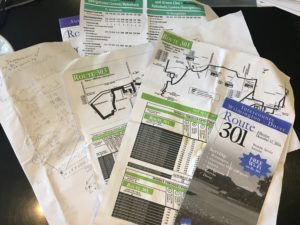 Biking your way on mass transit to southern Delaware from Center City Philly isn’t direct so first step was planning the train-bus transfers. The SEPTA transportation planning system is super simple, the DART website, not-so-much. But DART’s schedules do include station maps to help orient you – this was a major help in Georgetown, DE. My final plan:
Biking your way on mass transit to southern Delaware from Center City Philly isn’t direct so first step was planning the train-bus transfers. The SEPTA transportation planning system is super simple, the DART website, not-so-much. But DART’s schedules do include station maps to help orient you – this was a major help in Georgetown, DE. My final plan:
- SEPTA train from Jefferson Station to Wilmington, DE
- DART bus 301 from Wilmington to Dover, DE
- Transfer to DART 303 from Dover to Georgetown
- Then bike to a station down the street in Georgetown to catch the DART 204 from Georgetown to the Lewes Transportation Center
- Transfer to the DART 206 from the Lewes TC to the Dairy Queen in Lewes Beach
- Then bike 1.7 miles to my final destination and a margarita!
The SEPTA train from Jefferson Station to Wilmington, DE 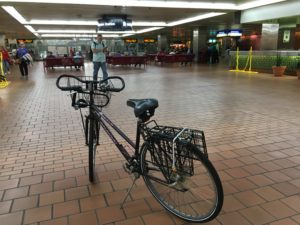 was easy: in the front door of the station, down the elevator to the concourse, get a ticket, down the elevator to the platform, onto the train to watch the scenery go by and think about
was easy: in the front door of the station, down the elevator to the concourse, get a ticket, down the elevator to the platform, onto the train to watch the scenery go by and think about 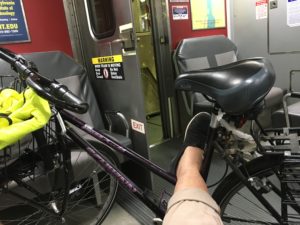 the next leg of the trip. Biking is catching on as a way to get to and from stations. On SEPTA trains bikes need to occupy the handicapped seating area. There were so many bikes on my train that a biker had to be turned away at University City station because there was no more room!
the next leg of the trip. Biking is catching on as a way to get to and from stations. On SEPTA trains bikes need to occupy the handicapped seating area. There were so many bikes on my train that a biker had to be turned away at University City station because there was no more room!
The connection time to the Delaware DART bus at Wilmington was generous so I had plenty of time to get on the very crowded elevator, buy a ticket, and get in line for the bus. I have become pretty accomplished at loading my bike onto the front bike rack of city buses but this was my first try at 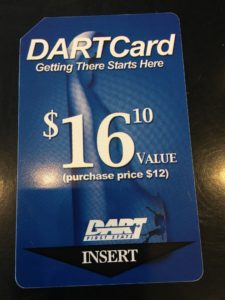 loading a bike into the baggage area under an inter-city bus. As I waited for the bus to arrive I fretted a lot about that loading but convinced myself that it would be okay – surely the driver would help – I was wrong.
loading a bike into the baggage area under an inter-city bus. As I waited for the bus to arrive I fretted a lot about that loading but convinced myself that it would be okay – surely the driver would help – I was wrong.
Instead, the driver shrugged, grunted, and gestured with a toss of his head toward the baggage compartment. Gulp! Thank goodness someone else had to put a bag under the bus or I wouldn’t have even found the compartment handle (no signage) AND thank goodness for the man who was sleeping in the bus kiosk who jumped up to help me load the bike and show me how to close the compartment door (no directions)!
DART has two ways to purchase a ticket: In the station you can buy a discounted multi-ride DARTCard or you can buy a Daily Pass on the bus. The Daily Pass option is a little less expensive and is great if you have lots of transfers to make in one day. I had left Philly with very little money and found the ATM machine in Wilmington was broken. The bus only takes cash so I bought a multi-ride DARTCard in the station; next time I will be better prepared.
I thought I would read my book on the one-hour ride to Dover. Instead I met Susie. She is a farmer from outside of Smyrna, DE who commutes on DART and SEPTA every day to Philly for radiation treatments. We talked about farming and American jobs and the price of things at Walmart and about her cancer and that she hoped to ring the bell on Thursday to announce she was cancer free. Her husband couldn’t go with her to Philly because he had to stay with the farm animals so she faced her treatments alone. Instead of worrying about herself, she worried about me on my bike and wanted to drive me to Lewes. She got off at the rest stop in Smyrna and I opened my book but only succeeded in staring out the window thinking about her.
The connection to the 303 was at the Dover Transportation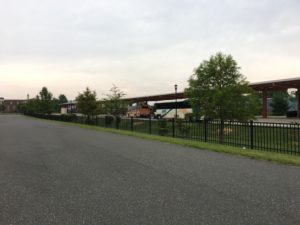 Center. This lonely outpost is a little off-putting. When I arrived, there were no other busses but there were lots of people and they were having quite a party – music playing, dancing, laughing, talking and sometimes yelling – it seemed just about everyone knew each other – most of them liked each other, others were not so popular and caused a bit of tension.
Center. This lonely outpost is a little off-putting. When I arrived, there were no other busses but there were lots of people and they were having quite a party – music playing, dancing, laughing, talking and sometimes yelling – it seemed just about everyone knew each other – most of them liked each other, others were not so popular and caused a bit of tension.
My bike had suffered a bit under the 301 so I took my layover as an opportunity to fix the chain and the brake and to then take a short check-out ride. Things quieted down after the Local 301 departed. The Express 301 to Georgetown had the familiar front bike rack so I loaded it up and off we went…. into the pouring rain.
My husband, after studying the DART schedules, had figured 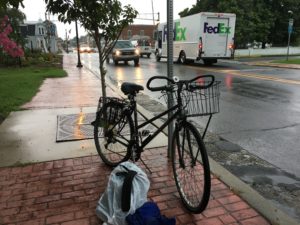
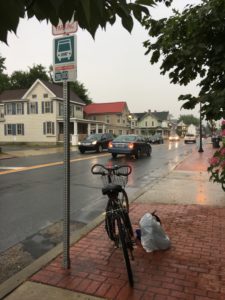 out that I would miss the connection at the Georgetown Transportation Center but that I could ride over to the next station and meet the 206 as it made its rounds of the city -he was right on the money. The bus was late – maybe it was the rain – so I had lots of time to stand under a very thickly growing Crape Myrtle, watch the traffic go by, and calculate how wet I would be by the time I biked the 12 miles to Lewes if the bus didn’t show up.
out that I would miss the connection at the Georgetown Transportation Center but that I could ride over to the next station and meet the 206 as it made its rounds of the city -he was right on the money. The bus was late – maybe it was the rain – so I had lots of time to stand under a very thickly growing Crape Myrtle, watch the traffic go by, and calculate how wet I would be by the time I biked the 12 miles to Lewes if the bus didn’t show up.
Then Anna showed up with a big umbrella. She knew all about the vagaries of the schedule, the drivers, the buses, the wait times, and the connections. She was positive that I would not have to head off on my bike. She also shared her umbrella which was a real plus since the Crape Myrtle was starting to drip like crazy.
Anna is here in the US on a student visa going to college in Georgetown during the day to study social work and working overnight in Lewes as a prep cook. She has no car and depends on DART for her 6 day a week commute from Georgetown to Lewes and back. The rain stopped just in time for the bus to arrive. I loaded my bike up on the front rack and off we went to Lewes.
Anna and I were the only ones to get off the 206 at the brand-new Lewes Transportation Center. We walked the 15 yards over to the 204 and, since it was locked up and the driver was having a siesta, we sat waiting in the bus shelter. We didn’t stay very dry because the rain drips over the roof and down onto the bench but at least we were out of the wind. We talked about the farm she grew up on, her family, what she likes about America, and how she misses her mom. We talked as we sat there, as we got on the bus, and then all the way down into town. She got off at the Zwaanendael Museum to walk over to Second Street. The driver and I continued on to the Dairy Queen where the bus drops you off on the sandy shoulder of the road – I wondered how it would handle a person with disabilities.
The rain stopped for the 1.7 mile bike ride from the bus stop. I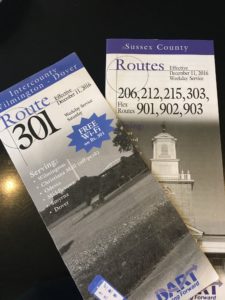 was surprised how relaxed I was and realized that the journey – except for dealing with that luggage compartment – had been relatively stress free. I am not sure how often I will choose the bike-train-bus-bus-bike-bus-bus-bike means of getting to Lewes but I know now that it is relatively easy and painless.
was surprised how relaxed I was and realized that the journey – except for dealing with that luggage compartment – had been relatively stress free. I am not sure how often I will choose the bike-train-bus-bus-bike-bus-bus-bike means of getting to Lewes but I know now that it is relatively easy and painless.
Next time you are getting ready to load up the car for a weekend jaunt or even a vacation, stop for a minute and consider taking your bike. Not just loading it on the back of the car, but using it for all or part of the trip as your transportation mode of choice. Combining biking with train-ing and bussing can get you far, help you get some exercise along the way, and arrive less stressed and refreshed. I didn’t get in as much reading as I had planned but I did meet interesting people and got to see the countryside from a different perspective.
Note: This trip had been a bit of a lark for me – an exercise in seeing if I could reduce my carbon footprint. For the other folk on the transit system it was their daily experience, their only means of transportation. There are always debates about fun ding mass transit, I encourage the folk engaged in those debates to get out and ride. I encourage them to listen to the stories the regular riders have to tell. I encourage them to look and listen to the communities at the transit centers. I think that the experience will make them see the need and be better advocates for mass transit. I know it has made me one.
